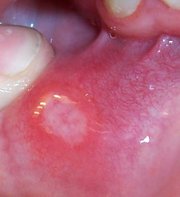Definition
Inflammation or the mucous lining of any of the structures in the mouth, which may involve the cheeks, gums, tongue, lips, and roof or floor of the mouth. The word "stomatitis" literally means inflammation of the mouth. The inflammation can be caused by conditions in the mouth itself, such as poor oral hygiene, poorly fitted dentures, or from mouth burns from hot food or drinks, or by conditions that affect the entire body, such as medications, allergic reactions, or infections.
Description
Stomatitis is an inflammation of the lining of any of the soft-tissue structures of the mouth. Stomatitis is usually a painful condition, associated with redness, swelling, and occasional bleeding from the affected area. Bad breath (halitosis) may also accompany the condition. Stomatitis affects all age groups, from the infant to the elderly.
Causes & symptoms
A number of factors can cause stomatitis. Poorly fitted oral appliances, cheek biting, or jagged teeth can persistently irritate the oral structures. Chronic mouth breathing due to plugged nasal airways can cause dryness of the mouth tissues, which in turn leads to irritation. Drinking beverages that are too hot can burn the mouth, leading to irritation and pain. Diseases, such as herpetic infections (the common cold sore), gonorrhea, measles, leukemia, AIDS, and lack of vitamin C can present with oral signs. Aphthous stomatitis, also known as "canker sores," is a specific type of stomatitis that presents with shallow, painful ulcers that are usually located on the lips, cheeks, gums, or roof or floor of the mouth. These ulcers can range from pinpoint size to up to 1 in (2.5 cm) or more in diameter. Though the causes of canker sores is unknown, nutritional deficiencies, especially of vitamin B12, folate, or iron is suspected. Generalized stomatitis can result from excessive use of alcohol, spices, hot food, or tobacco products. Sensitivity to mouthwashes, toothpastes, and lipstick can irritate the lining of the mouth. Exposure to heavy metals, such as mercury, lead, or bismuth can cause stomatitis. Thrush, a fungal infection, is a type of stomatitis.
Diagnosis
Diagnosis of stomatitis can be difficult. A patient's history may disclose a dietary deficiency, a systemic disease, or contact with materials causing an allergic reaction. A physical examination is done to evaluate the oral lesions and other skin problems. Blood tests may be done to determine if any infection is present. Scrapings of the lining of the mouth may be sent to the laboratory for microscopic evaluation, or cultures of the mouth may be done to determine if an infectious agent may be the cause of the problem.
Treatment
The treatment of stomatitis is based on the problem causing it. Local cleansing and good oral hygiene is fundamental. Sharp-edged foods such as peanuts, tacos, and potato chips should be avoided. A soft-bristled toothbrush should be used, and the teeth and gums should be brushed carefully; the patient should avoid banging the toothbrush into the gums. Local factors, such as ill-fitting dental appliances or sharp teeth, can be corrected by a dentist. An infectious cause can usually be treated with medication. Systemic problems, such as AIDS, leukemia, and anemia are treated by the appropriate medical specialist. Minor mouth burns from hot beverages or hot foods will usually resolve on their own in a week or so. Chronic problems with aphthous stomatitis are treated by first correcting any vitamin B12, iron, or folate deficiencies. If those therapies are unsuccessful, medication can be prescribed which can be applied to each aphthous ulcer with a cotton-tipped applicator. This therapy is successful with a limited number of patients.
Alternate treatment
Alternate treatment of stomatitis mainly involves prevention of the problem. Patients with dental appliances such as dentures should visit their dentist on a regular basis. Patients with systemic diseases or chronic medical problems need to ask their health care provider what types of oral problems they can expect from their particular disease. These patients must also contact their medical clinic at the first sign of problems. Common sense needs to be exercised when consuming hot foods or drinks. Use of tobacco products should be discouraged. Alcohol should be used in moderation. Mouthwashes and toothpastes known to the patient to cause problems should be avoided.
Botanical medicine can assist in resolving stomatitis. One herb, calendula (Calendula officinalis), in tincture form (an alcohol-based herbal extract) and diluted for a mouth rinse, can be quite effective in treating aphthous stomatitis and other manifestations of stomatitis.
Prognosis
The prognosis for the resolution of stomatitis is based on the cause of the problem. Many local factors can be modified, treated, or avoided. Infectious causes of stomatitis can usually be managed with medication, or, if the problem is being caused by a certain drug, by changing the offending agent.
Prevention
Stomatitis caused by local irritants can be prevented by good oral hygiene, regular dental checkups, and good dietary habits. Problems with stomatitis caused by systemic disease can be minimized by good oral hygiene and closely following the medical therapy prescribed by the patients health care provider.
Key Terms
- Aphthous stomatitis
- A specific type of stomatitis presenting with shallow, painful ulcers. Also known as .
- Stomatitis
- Inflammation of the lining of the mouth, gums, or tongue.
- Thrush
- A form of stomatitis caused by fungi and characterized by cream-colored or bluish patches on the tongue, mouth, or pharynx.
Further Reading
For Your Information
Books
- Conn's Current Therapy, edited by Robert Rakel. Philadelphia: W.B. Saunders, 1997.
- The Merck Manual, edited by Robert Berkow. Rahway, NJ: Merck Sharp & Dohme Research Laboratories, 1987.
Organizations
- American Dental Association. P.O. Box 776, St. Charles, IL 60174-0776. (312) 440-2500. http://www.ada.org.
- American Medical Association. 515 N. State St, Chicago, IL 60612. (312) 464-5000. http://www.ama-assn.org.
Gale Encyclopedia of Medicine. Gale Research, 1999.



